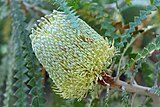Banksia speciosa, the showy banksia, is a large shrub or small tree in the family Proteaceae. First collected and described by Robert Brown in the early 19th century, the species occurs on the south coast of Western Australia between Hopetoun and the Great Australian Bight, growing on white or grey sand in shrubland. Reaching up to 8 m (26 ft) in height, it is a single-stemmed plant that has thin leaves with prominent triangular "teeth" along each margin, which are 20–45 cm (7.9–17.7 in) long and 2–4 cm (0.8–1.6 in) wide. The prominent cream-yellow flower spikes appear throughout the year, developing up to 20 follicles each that store seeds until opened by bushfire. Though widely occurring, the species is highly sensitive to dieback. The flowers attract nectar- and insect-feeding birds, particularly honeyeaters. In cultivation, B. speciosa grows well in a sunny location on well-drained soil in areas with dry summers. (Full article...)
